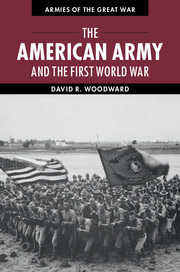Book contents
- Frontmatter
- Dedication
- Contents
- List of figures
- List of maps
- List of tables
- Preface
- List of abbreviations
- Introduction
- 1 Birth of a modern army
- 2 World war and American preparedness
- 3 Coercive power and Wilsonian diplomacy
- 4 “You’re in the army now”
- 5 US army doctrine and industrialized trench warfare
- 6 Over where?
- 7 American Expeditionary Force organization, overseas training, and deployment
- 8 Will the Americans arrive in time?
- 9 Failed expectations: “the military establishment of the United States has fallen down”
- 10 Atlantic ferry
- 11 Neck of the bottle
- 12 Uncertain times
- 13 Cantigny
- 14 Into the breach
- 15 American soldiers in north Russia and Siberia
- 16 The beginning of the end
- 17 Establishment of the American First Army and Saint-Mihiel
- 18 Meuse-Argonne, September 26–October 31
- 19 Breakout, November 1–11
- 20 Epilogue
- Notes
- Bibliography
- Index
7 - American Expeditionary Force organization, overseas training, and deployment
Published online by Cambridge University Press: 05 July 2014
- Frontmatter
- Dedication
- Contents
- List of figures
- List of maps
- List of tables
- Preface
- List of abbreviations
- Introduction
- 1 Birth of a modern army
- 2 World war and American preparedness
- 3 Coercive power and Wilsonian diplomacy
- 4 “You’re in the army now”
- 5 US army doctrine and industrialized trench warfare
- 6 Over where?
- 7 American Expeditionary Force organization, overseas training, and deployment
- 8 Will the Americans arrive in time?
- 9 Failed expectations: “the military establishment of the United States has fallen down”
- 10 Atlantic ferry
- 11 Neck of the bottle
- 12 Uncertain times
- 13 Cantigny
- 14 Into the breach
- 15 American soldiers in north Russia and Siberia
- 16 The beginning of the end
- 17 Establishment of the American First Army and Saint-Mihiel
- 18 Meuse-Argonne, September 26–October 31
- 19 Breakout, November 1–11
- 20 Epilogue
- Notes
- Bibliography
- Index
Summary
The US Army could not have been less prepared to wage war abroad when Wilson decided to send an expeditionary force to Europe. As Pershing recalled later in his memoirs:
Figuratively speaking, then, when the Acting Chief of Staff went to look in the secret files, where the plans to meet the situation that confronted us should have been found, the pigeonhole was empty. In other words, the War Department was faced with the question of sending an army to Europe and found that the General Staff had never considered such a thing. No one in authority had any definite idea how many men might be needed, how they should be organized and equipped, or where the tonnage to transport and supply them was to come from.
On the voyage to Europe, the decisions made by Pershing and his staff had serious implications for their European partners. Only in Lorraine did Pershing and his staff believe that an American campaign could play a decisive role in ending the war. Desperate to acquire American assistance for their war-weary army, the French welcomed, even encouraged, the positioning of US forces in the Lorraine sector between the Argonne Forest and the Vosges Mountains. But the French to their dismay soon came to understand how much GHQ’s plan to capture Metz dominated Pershing’s expectations of the role US forces would play in 1918.
- Type
- Chapter
- Information
- The American Army and the First World War , pp. 106 - 122Publisher: Cambridge University PressPrint publication year: 2014



